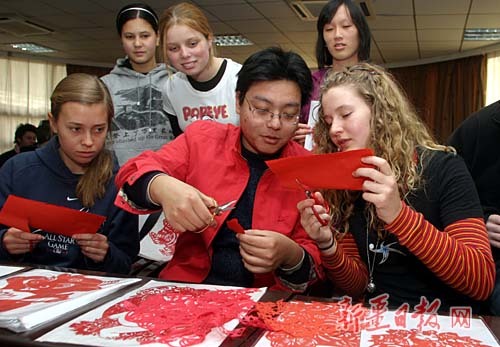If a foreigner learning Chinese asks a Chinese friend why it is correct to say "I have lived in Beijing for three weeks", but wrong to say "I have lived in Thailand for three years", or why it is correct to say "She looks a little bit ugly", but wrong to say "He looks a little bit handsome", that foreigner is clearly confused and in need of guidance.
|

|
|
A file photo show foreign students learn traditional Chinese paper-cutting art. The number of people around the world learning Chinese has passed 40 million globally. |
With these tricky questions, a Chinese fluent in Mandarin but without training in teaching the language could simply explain that these sentences are just how Chinese people speak. But that explanation is rather weak and can reveal the shortcomings of studying Chinese as a subject.
Excluding China, there are currently 3,000 schools providing Chinese courses in 109 countries around the world. The number of people around the world learning Chinese has passed 40 million globally.
The numbers detailing the efforts by Hanban, the Chinese National Office For Teaching Chinese as a Foreign Language (who supervise the chain of?Confucius Institutes), to teach Chinese is staggering: 4,000 volunteers have been sent to 150 countries; it has trained 20,000 Chinese language teachers within 40 countries.
The United States even made Mandarin one of its six critical languages to research for security reasons, putting in a tremendous amount of funds for research.
This massive drive to learn and teach Mandarin indicates that while China's national power is growing 30 years after its reform and opening-up, the nation's soft power has also grown. The Chinese culture is attracting more and more attention. Some critics have claimed that "The spring of Chinese-language teaching is coming".
But that doesn't mean there aren't any problems in how Chinese is being taught.
First, China needs to pay greater attention to courses that teach Chinese students how to teach Chinese to speakers of other languages. Students and parents I've talked to doubt that taking courses in how to teach Chinese is necessary. Some think that as long as the person is Chinese and can speak Chinese fluently, that person can then teach Chinese.
But for a Mandarin-speaking Chinese who haven't been systematically trained on how to teach Chinese, it will be impossible to answer questions such as why it is wrong to say: "I have lived in Thailand for three years". They wouldn't be able to answer the question of why it is correct to say "She looks a little bit ugly", but incorrect to say "He looks a little bit handsome".
Secondly, it is still difficult to spread the Chinese culture to the world. China has a history that stretches back 5,000 years. But even though many of my foreign friends know of Chinese scholars, such as Confucius and Lao Zi, few people know of Lu Xun, a Chinese writer and intellectual of the 20th century.
People in Europe and the United States might know nothing about modern China, except kungfu star Jackie Chan.
But in the phenomenon of learning Chinese that is sweeping the world, most of the passion from Westerners comes from their curiosity and appreciation of traditional Chinese culture.
Since they are paying more attention to old China and therefore know little about modern China, it is important for China to cultivate its modern culture and do a better job of introducing it to Westerners.
So how does China effectively market the Chinese culture? How does the nation steer the world's attention away from China's past to better focus on China's present? Answering these questions is the biggest issue for China in building its national soft power.
Thirdly, there is still a long way to go before the Chinese language becomes the lingua franca. Some Chinese are overly optimistic that Chinese has become the dominant language in the world and the truth is that English is still the dominant language. Eighty-five percent of content on the Internet is in English. Worldwide, there are two billion people learning English and the number of English learners in China has surpassed the number of Chinese learners globally.
Who is learning Chinese? It is understood that most foreigners learn Chinese for professional and educational reasons. Another group is the second or third generation of overseas Chinese migrants, most of them forced by their parents to learn their mother tongue.
If these are the only reasons why people learn Chinese, you could say that the language is more popular than it was 20 years ago, but that wouldn't be correct.
China urgently needs to train more international Chinese teachers. According to statistics by Hanban, about 10,000 teachers are needed a year. With such a large demand for teachers, inadequate training could lead to counterproductive results.
Teaching Chinese has its own regulations and rules. A teacher who can speak Chinese might not be a good teacher. Teachers must also have a rich knowledge and background in Chinese culture and the ability to speak the learner's mother tongue. They should also be aware of common mistakes that students make and be able explain them.
"It's the habit of Chinese people" is not the answer for speakers of other languages. Teachers who want to teach Chinese should go through rigorous training before landing a job teaching the language.
People around the world learning is certainly a good thing. It is a good time for Chinese to go abroad. But China should not be satisfied and overly optimistic. It needs to develop the country's economic power, improve the innovative ability of Chinese nationals, build up the language as a subject; strengthen the study of Chinese as a mother tongue, and make Chinese the most powerful language of the world.
The author is from the international cultural studies department of Capital Normal University in Beijing.
(China Daily, China.org.cn?May 6, 2011)